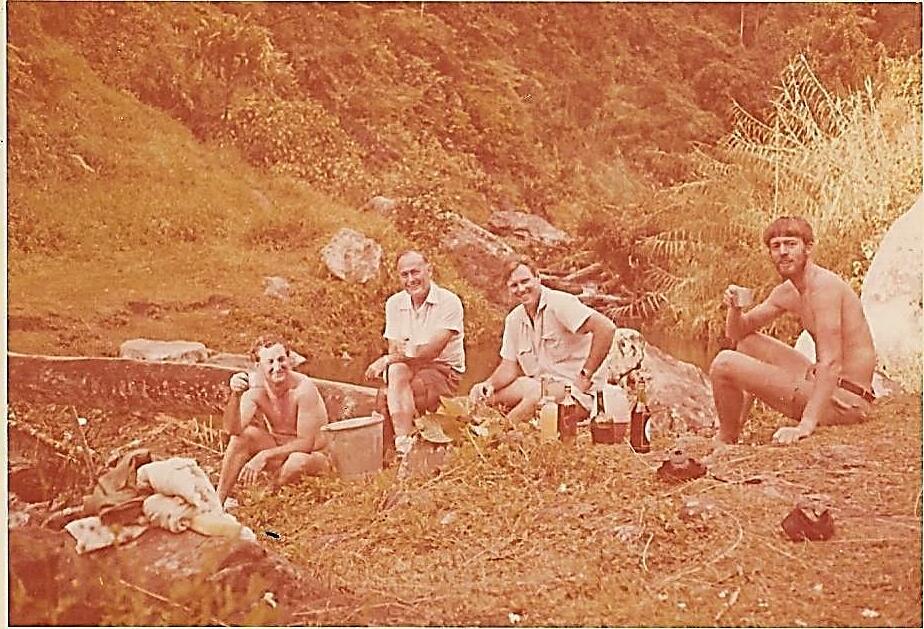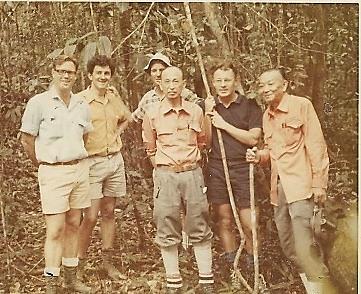
6 minute read
Efogi
from PNGAF MAG ISSUE # 9D-5B4T2 of 21st Aug 2022 Eminent TPNG Forester Dr Bob Thistlethwaite 1971-1975
by rbmccarthy
“EFOGI” Paper submitted by Dr Robert Thistlethwaite 20/12/2019
Fig 1: Source: Adventure Kokoda Treks – a useful borrowed depiction.
Advertisement
Kev White phoned to say he had arranged a flight to Efogi for the coming Saturday and did I want to come. Early on Saturday (no date but around the 30th anniversary of the Battle of Brigade Hill), we flew from Jacksons, Kev in the jump seat while Alan White, Chris Done and I piled into the rear. An uneventful short flight and landed at Efogi airstrip after an interesting approach among the hills. We taxied up to the eastern end where the Kokoda Track leads to Efogi, cargo, botanical presses, etc., and looked for the usual porters and bevy of children who greet visitors on arrival at more remote PNG airstrips. A radio message had been sent to Efogi advising our short visit and need to use the Haus Kiap for the night —but no-one was in sight.

Chris Done on left and Kevin White on right reach Efogi village.
An SDA village, clean and attractive, with many fruit trees. We waited, but still no one appeared, so carried the cargo to the village ourselves. All was silent. Had we offended the people in some way and were receiving the treatment? or perhaps our radio message had not reached the right ears? The village was immaculate,
clean, and swept, well-maintained houses, etc., but no people, old or young, to be seen anywhere. There was no point in speculating on causes, so we made our way to the Haus Kiap and dumped the gear. While no human being was to be seen, we soon realised from faint murmurs of human voices that there were people inside the closed-up houses. But incredibly quiet for a village; no dogs barking, no pigs grunting, hens clucking, or cocks crowing. Extraordinary! We had hoped to arrange some cooked food for dinner that evening but it looked like we were in for a lean time. We ate some crackers, collected the gear we needed, stowed some refreshments in a haversack, and headed north from the village.
Belatedly in our stupidity, it dawned on us that we were in an SDA village, where Saturday is their Sabbath and strictly observed. Had we done our homework better, we would have been reminded that the SDA church had many adherents in that area and flown in another day. Well, we were there, and not tourists, so we headed for the forest and trees we wanted to see. I was interested particularly in E. tereticornis in that part of the Owen Stanleys.
[A little Aside. The Efogi Village we visited was not the wartime village. That village had been on the wartime Track which veered left at Brigade Hill along Mission Ridge. This was the scene of bitter fighting in September 1942 when 6 Battalions of Japanese troops of the 144th South Seas Island Regiment attacked Brigadier Potts ragged remnants of his 21st Brigade numbering nominally about 1,000 retreating Australian troops with the greatest losses during the Kokoda campaign of 87 killed and 77 wounded. The wartime track on Mission Ridge passed through the former Efogi Village and then on to Kagi, the then largest village in the area. In the accounts of the Kokoda campaign, you will read that the Track crossed Efogi Creek; it did in 1942, but in 1972 the track out of (new) Efogi crossed Elome Creek and then climbed steeply up to Launumu (marked on the map as Launumu). Today’s Efogi is the largest village along the track with a population said to be about 350.] A couple of miles north of Efogi we decided to take a break from our exercise at Elome Creek, which at that time was much less than the 10m width stated on the map - although with heavy rain, the stream would rise very fast. It was hot and the water in the creek was inviting. Alan and Chris could not resist a dip, but the water was too cold for me.

Elome Creek: From left: Allan White, Kev White, Chris Done. I was taking the photo. (B&W clearer)

Efogi. A hard Saturday afternoon at Elome Creek a short walk north of Efogi. From left: Alan White, Kev White, Bob
Thistlethwaite, Chris Done. Photo credit Bob Thistlethwaite.
The walk up to Launumu was stiff for the four of us, but more so for Kev. Of course, he would not admit that but happened upon an excellent spot at a bend in the track from which to enjoy the vista. We had no objection to gazing at the scenery either. While having a breather, two young boys ran past us uphill to Launumu with a cherry apinun masta. Reinvigorated by their youthfulness and mountain legs, we carried on, reaching Launumu with thoughtful admiration for those Aussie soldiers who had fought through this country carrying very heavy loads rather than the skimpy weight we carried.

At Launumu (Launumu in the 1970s) near which the Track forks. Launumu had a few people out and about. I was impressed by form, diameter, and bole length of some E. tereticornis along the ridge, and we were taken to the site of a church being rebuilt to examine the stumps of the prior church which had stood for many years.
The photo of the kapset posts tells the story of only a thin skin of external rot, and posts which would support the new church for many years to come. The large posts are Eucalyptus tereticornis stumps from the old lotu. The posts had been kapset with a thin skin of punky wood shaved off at the post top (originally in the ground). Tereticornis is highly prized for posts. No wonder this species is prized by the
Koiari people.
DoF later collected seed from E. tereticornis at Dobodura (for firewood production) which was sent to Dehra Dun in India. Parcels of that seed had been distributed to drier areas of India, and seed of Australian provenances had been imported to Tamil Nadu in the 1800s and used in some tea growing areas for high shade. During a visit in Himachal Pradesh in the Western Himalayas, I was impressed by plantings on dry southerly aspects to help stabilise land slip and for firewood. I tried to find out more about those plantings in the Forestry Office in Simla, the capital, and was confronted by a copy of a DoF Phytosanitary Certificate signed by yours truly. It was the seed from Dobodura. But the Efogi provenance was more
impressive, and I regretted DoF was unable to collect seed there at the time or for that matter from other known stands in the Owen Stanleys.
The light was waning, and we hurried back to Efogi arriving about 5.30pm. Still all quiet. Then at 6pm a bell rang and suddenly the Efogi area was awash with people, cheerful, friendly, and courteous. The Sabbath had ended. We had many offers of food and purchased a couple of chickens for supper. We did not display alcohol of course, and we did not need to be concerned about savage pigs under houses.

Efogi airstrip.
The white spot in the centre background is our plane making its approach.
Photo credit Bob Thistlethwaite.








